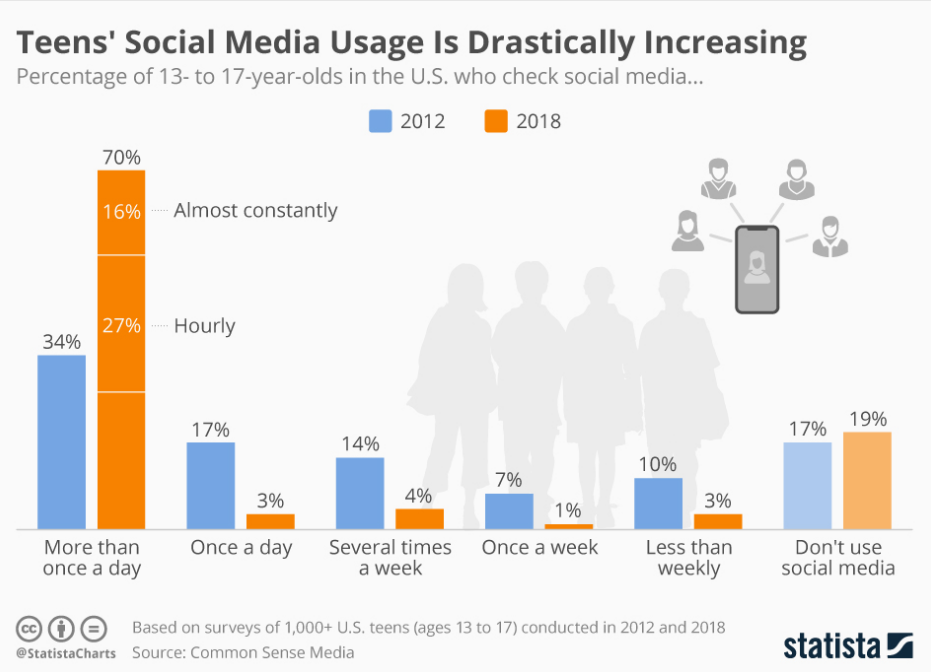
Moonpreneur
Growing up in India, television was the only source of entertainment and the only screen we were exposed to. And the content shown on the tiny screen was limited.
It’s fascinating to look back and remember how subtle gestures and symbols were employed to depict romance, such as two flowers gently touching each other.
Violent scenes were often edited out from movies before being aired on television.
It was a different era, characterized by a more restrained approach to content presentation than the wide range of options and explicit material available today.
We want to address a concern that has been keeping many parents awake at night—the impact of social media on their children’s lives. Social media is a powerful tool that can be used for both good and bad. As a kid’s education company, we are responsible for providing data-driven insights on this topic.
Let’s begin with the positive aspects. Social media can help kids stay connected with friends and family, facilitate learning, and provide a platform for self-expression. However, we cannot ignore the potential risks and negative consequences associated with its use.
According to a Pew Research Center study, 95% of teens in the United States use social media. Moreover, the average teen spends approximately 9 hours daily engaging in social media activities.
These numbers should catch our attention, as excessive use has been linked to anxiety and depression among teenagers. The same study found that teens who spend more than 3 hours a day on social media are more likely to experience these mental health issues.

Cyberbullying is another prevalent concern. The University of Pittsburgh conducted a study revealing that teenagers who use social media for over 2 hours daily are at a higher risk of being bullied and bullying others.
These statistics paint a clear picture—parents need to set limits and be actively involved in their children’s social media usage.
So, how can parents effectively manage their kids’ social media engagement?
First and foremost, open communication is vital. Talk to your children about the risks associated with social media, including addictive behaviors, cyberbullying, and exposure to inappropriate content. You can encourage them to share their experiences and concerns by fostering an environment of trust and understanding.
Setting limits on social media use is crucial. Establish clear guidelines on how much time your child can spend on social media, and ensure these limits are adhered to. Doing so, you help create a healthy balance between online and offline activities.
Monitoring your child’s social media activity is another essential step. Keep an eye on what platforms they are using and what content they are consuming. This doesn’t mean invading their privacy but staying informed and openly discussing concerns.
Engage in conversations with your children about their social media experiences. Ask them about the friends they make online, the content they come across, and how they feel about their interactions. This will not only help you gain insight into their digital world but also enable you to identify and address any potential issues.
Equipping your children with critical thinking skills is paramount. Teach them how to evaluate the information they encounter online, spot fake news, and identify misinformation. This will empower them to make informed decisions and navigate the digital landscape more safely.
Finally, it’s crucial to be supportive. If your child faces challenges or struggles with social media, provide a listening ear and offer guidance. Help them develop coping mechanisms to handle cyberbullying or other online difficulties. Remember, your support can make all the difference in their digital well-being.
Now, let’s talk about the tools available to assist parents in monitoring their children’s social media usage.
Parental control apps have gained popularity, offering features like watching social media, time limits, and filtering content.
Here are a few well-regarded options:
- Bark: This parental control app monitors social media, text messages, and email for signs of cyberbullying, inappropriate content, and other potential problems.
- Qustodio: Another popular choice, Qustodio provides a range of features, including social media monitoring, time limits, and website blocking.
- MMGuardian: Focused on social media monitoring and filtering, MMGuardian offers comprehensive parental control features.
- Norton Family: Norton Family is a comprehensive parental control suite that includes social media monitoring, time limits, and website blocking.
- FamiSafe: Offering features such as social media monitoring, time limits, and location tracking, FamiSafe is an effective parental control app.
When selecting a parental control app, consider your child’s age, the features you require, and your budget. It’s crucial to read reviews, compare features, and choose an app that meets your needs.
However, it’s important to note that better solutions exist than parental control apps. While they can assist in monitoring your child’s social media usage, they should not replace open communication and trust. Engage in conversations with your child about the risks of social media, set clear expectations, and work together to ensure their online safety.
In conclusion, the impact of social media on our children’s lives must be addressed. Thank you for your attention, and let us continue our mission to empower children in the digital age.
Looking for a comprehensive parenting guide to ensure you are on the right track? Explore a wealth of parenting wisdom and educational insights in Moonpreneur’s blogs. Additionally, you can join our programs that nurture the next generation of innovators. Book a free trial now!
























What measures can I take to guide my children in using social media responsibly?
In today’s context, prioritizing privacy settings is crucial. Expressing concern for the kid’s well-being, I advise going through these settings together to ensure that he comprehends each one. It’s important to clarify that passwords play a vital role in protecting against issues like identity theft, emphasizing the rule that they should never be shared with anyone, including close connections such as boyfriends, girlfriends, or best friends.
Follow these four steps to monitor your children’s social media engagement.